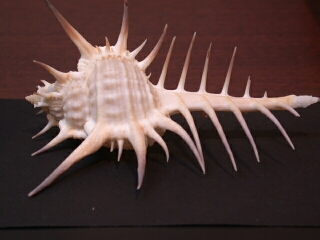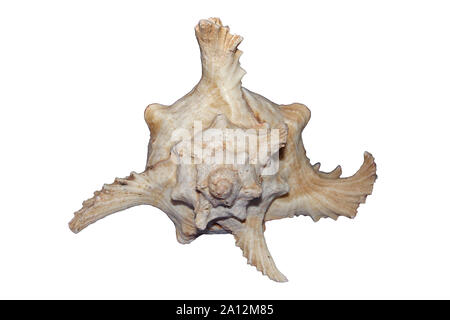
This murex occurs in shallow, sublittoral waters. This species lives in the Mediterranean Sea and the Atlantic coasts of Europe and Africa, specifically Spain, Portugal, Morocco, the Canary Islands, Azores.
 Hexaplex trunculus trunculus (Linnaeus, 1758). The dye will turn indigo blue, similar to the color of blue jeans, if exposed to sunlight before the dye sets. One of the dye's main chemical ingredients is red dibromo- indigotin, the main component of tyrian purple or tekhelet. Ancient Mediterranean cultures, including the Minoans, Canaanites/ Phoenicians, Hebrews, and classical Greeks created dyes from the snails. This sea snail is historically important because its hypobranchial gland secretes a mucus used to create a distinctive purple-blue indigo dye. Fossilized shells have been found in Morocco, Italy, and Spain. The snail appears in fossil records dating between the Pliocene and Quaternary periods (between 3.6 and 0.012 million years ago). What is peculiar about this specific species is that they show no preference for the size of their prey, regardless of their hunger levels. This species is a group of opportunist predatory snails that are known to attack their prey in groups. It is included in the subgenus Trunculariopsis. Hexaplex trunculus (previously known as Murex trunculus, Phyllonotus trunculus, or the banded dye-murex) is a medium-sized sea snail, a marine gastropod mollusk in the family Muricidae, the murex shells or rock snails. Trunculariopsis trunculus ( Linnaeus, 1758).
Hexaplex trunculus trunculus (Linnaeus, 1758). The dye will turn indigo blue, similar to the color of blue jeans, if exposed to sunlight before the dye sets. One of the dye's main chemical ingredients is red dibromo- indigotin, the main component of tyrian purple or tekhelet. Ancient Mediterranean cultures, including the Minoans, Canaanites/ Phoenicians, Hebrews, and classical Greeks created dyes from the snails. This sea snail is historically important because its hypobranchial gland secretes a mucus used to create a distinctive purple-blue indigo dye. Fossilized shells have been found in Morocco, Italy, and Spain. The snail appears in fossil records dating between the Pliocene and Quaternary periods (between 3.6 and 0.012 million years ago). What is peculiar about this specific species is that they show no preference for the size of their prey, regardless of their hunger levels. This species is a group of opportunist predatory snails that are known to attack their prey in groups. It is included in the subgenus Trunculariopsis. Hexaplex trunculus (previously known as Murex trunculus, Phyllonotus trunculus, or the banded dye-murex) is a medium-sized sea snail, a marine gastropod mollusk in the family Muricidae, the murex shells or rock snails. Trunculariopsis trunculus ( Linnaeus, 1758). 
tetragona Stalio in Coen, 1933 (infrasubspecific name, not recognized by ICZN) Murex taurinensis Bellardi & Sacco, 1872 (dubious synonym).Murex solidior Monterosato in Franceschini, 1906.Murex soldanii meneghini de Stefani, 1875.
 Murex portulanus Monterosato in Franceschini, 1906. Murex neomagensis Fontannes, 1879 (dubious synonym).
Murex portulanus Monterosato in Franceschini, 1906. Murex neomagensis Fontannes, 1879 (dubious synonym). 
Murex fasciatus Risso, 1826 (invalid: junior homonym of Murex fasciatus Gmelin, 1791). Murex falcatus Sandri & Danilo, 1856 (invalid: junior homonym of Murex falcatus G.B. Murex coronatus Monterosato in Franceschini, 1906. Murex armigerus Settepassi, 1970 (not available, published in a work which does not consistently use binomial nomenclature (ICZN art. Hexaplex (Trunculariopsis) trunculus (Linnaeus, 1758).








 0 kommentar(er)
0 kommentar(er)
